
REPRINTS

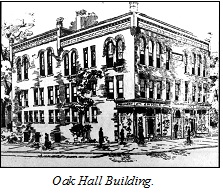 A serious fire in South Manchester in 1909 demonstrated the need for motorized apparatus, or better yet a
pumping engine, in South Manchester. The Oak Hall building stood on the corner of Main and Oak Streets. The
building had been constructed on May 22, 1897 with an addition to the rear being completed in October 1905 and
was owned by the Ferris Brothers. The main tenants were the J. W. Hale Dry Goods store and the C. E. House
clothing store.
A serious fire in South Manchester in 1909 demonstrated the need for motorized apparatus, or better yet a
pumping engine, in South Manchester. The Oak Hall building stood on the corner of Main and Oak Streets. The
building had been constructed on May 22, 1897 with an addition to the rear being completed in October 1905 and
was owned by the Ferris Brothers. The main tenants were the J. W. Hale Dry Goods store and the C. E. House
clothing store.
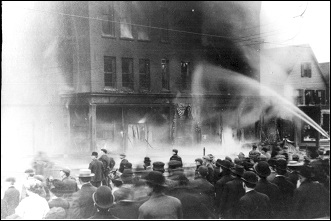
It was the practice of many Main Street merchants in these days to store waste paper and boxes in their
basements and to then burn their rubbish behind their stores. At a Business Men's meeting in 1903, Main Street
business owner Fred T. Blish announced that he had received an order from the fire department to discontinue
burning rubbish behind his building. There was a state law against the practice and the matter was brought to
the attention of Chief Atwood for action. A notice was sent out to all Main Street businesses immediately to
stop the practice.
Six years later, however, at 4:40 PM on the afternoon of April 12, 1909, rubbish being burned behind the
Oak Hall building ignited clothing and dress goods boxes stored in the basement. An alarm was sounded from box
#44 at 4:43 PM. The first piece of apparatus on the scene was the hose cart of Company No. 3. They immediately
went to the closest hydrant which was at the corner of Main and Oak Street. At the time, the fire was not large
and possibly could have been extinguished rapidly were it not for the fact that the hydrant had an apparatus
attached with which to fill a watering cart, and the hydrant had been left turned on by the cart operator. By
the time the hydrant situation was resolved, the fire had spread up the wooden rear stairway and into the
basement and was viciously attacking the building. Companies No. 2, 3 and 4 responded to the original alarm,
and a general alarm was turned in at 4:58 PM bringing Company No. 1 to the scene.
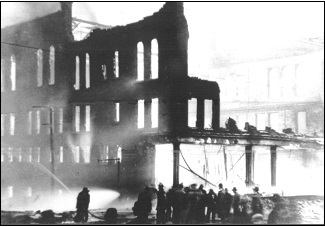 It was not long before the water system was overtaxed with as many as ten hose lines operating and by five
o�clock it was obvious that the building was beyond saving. In a short time, fire had spread through all floors
of the brick building and turned the interior into a blast furnace. Fire fighters' efforts were soon directed
toward saving neighboring structures. Fires had started on many of the awnings and roofs to the north along
Main Street all the way to Birch Street, and it looked as though much of Main Street would be lost. At one time,
there were as many as seven fires burning. The ruins of the previously burned American Hotel caught fire, as
well as, part of the Ferris Building. The Orford Hotel at one time had five different fires going, two on the
fifth floor, two on the fourth floor and one between the floors. A fire was started in the Weldon block which
was put out with an extinguisher. The awning on the Waranoke Hotel caught fire, but was torn away. A small
wooden building north of the Waranoke caught fire five times, but was held in check. Farther north, the roof of
the home of Herbert House was ignited by sparks, but was also extinguished without much work.
It was not long before the water system was overtaxed with as many as ten hose lines operating and by five
o�clock it was obvious that the building was beyond saving. In a short time, fire had spread through all floors
of the brick building and turned the interior into a blast furnace. Fire fighters' efforts were soon directed
toward saving neighboring structures. Fires had started on many of the awnings and roofs to the north along
Main Street all the way to Birch Street, and it looked as though much of Main Street would be lost. At one time,
there were as many as seven fires burning. The ruins of the previously burned American Hotel caught fire, as
well as, part of the Ferris Building. The Orford Hotel at one time had five different fires going, two on the
fifth floor, two on the fourth floor and one between the floors. A fire was started in the Weldon block which
was put out with an extinguisher. The awning on the Waranoke Hotel caught fire, but was torn away. A small
wooden building north of the Waranoke caught fire five times, but was held in check. Farther north, the roof of
the home of Herbert House was ignited by sparks, but was also extinguished without much work.
At the height of these fires, Charles Cheney telephoned the Hartford Fire Department for assistance. Horace
B. Clark, who was president of the Hartford Board of Fire Commissioners at the time of the fire, had driven to
Manchester to watch the fire along with Chief Krug of the Hartford Fire Department. By the time Chief Krug
arrived, he deemed that the worst of the fire was over and that aid from Hartford was no longer needed, but a
seed had been planted in Horace B. Clark�s mind concerning a �mutual aid� system whereby aid would be offered
and received from towns surrounding Hartford who were equipped to reciprocate. The Hartford County Mutual Aid
system is still in place today and is employed frequently.
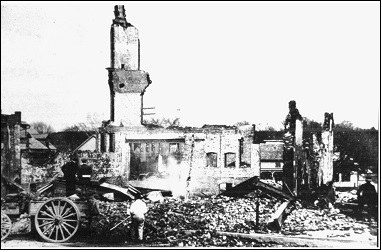 In the early stages of the fire, it was determined that it would be a good idea to remove a 30-gallon metal
tank containing gasoline which was stored in a tin building between the American Hotel and the Ferris building.
A horse-drawn dump cart operated by Andrew Gardner was secured and the tank was loaded into the cart. As the
cart bumped over the sidewalk onto the street, a quantity of gasoline was spilled and the jostling of the cart
startled the horse. The horse sped up which caused more of the gasoline to spill onto the street, resulting in
a trail up Main Street. The flames from the fire ignited the spilled gasoline and the fire began chasing the
cart and horse up the street, unnoticed by the driver. When the yelling of the crowd alerted Mr. Gardner to
what was happening, he jumped from the cart and was quickly assisted in cutting the horse free from the reins.
From a safe distance Mr. Gardner, and the horse, watched the cart and its cargo go up in flames. Ferris Brothers
received a bill shortly after for the cost of the destroyed cart. By 6:00 PM, the walls of the building and the
addition had fallen in. Attention was directed to the American Hotel ruins and the Ferris Building where several
hoses were operating. Water damage to the Ferris building was considerable. The entire incident was declared
under control at 7:15 P.M. and the recall was sounded at 10:27 P.M. The loss was estimated at $120,000 which
was the largest loss since the formation of the department.
In the early stages of the fire, it was determined that it would be a good idea to remove a 30-gallon metal
tank containing gasoline which was stored in a tin building between the American Hotel and the Ferris building.
A horse-drawn dump cart operated by Andrew Gardner was secured and the tank was loaded into the cart. As the
cart bumped over the sidewalk onto the street, a quantity of gasoline was spilled and the jostling of the cart
startled the horse. The horse sped up which caused more of the gasoline to spill onto the street, resulting in
a trail up Main Street. The flames from the fire ignited the spilled gasoline and the fire began chasing the
cart and horse up the street, unnoticed by the driver. When the yelling of the crowd alerted Mr. Gardner to
what was happening, he jumped from the cart and was quickly assisted in cutting the horse free from the reins.
From a safe distance Mr. Gardner, and the horse, watched the cart and its cargo go up in flames. Ferris Brothers
received a bill shortly after for the cost of the destroyed cart. By 6:00 PM, the walls of the building and the
addition had fallen in. Attention was directed to the American Hotel ruins and the Ferris Building where several
hoses were operating. Water damage to the Ferris building was considerable. The entire incident was declared
under control at 7:15 P.M. and the recall was sounded at 10:27 P.M. The loss was estimated at $120,000 which
was the largest loss since the formation of the department.
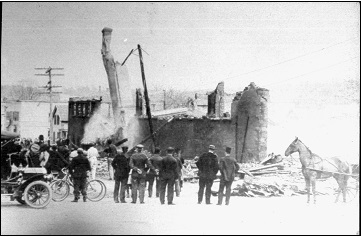 Immediately following the fire, the building was demolished. By April 17, 1909, Isaac A. Allen of Hartford
had already been retained to prepare plans for a new building. It was to be a two story brick building much
larger than the one that was destroyed by fire, but one story lower. The Oak Hall Building Company, which was
really C. E. House and J. W. Hale, bought a small two-story building just south of the burned out building from
C. E. House. It was to be moved to the rear of the burned building on Oak Street which was to be added to and
used as a temporary store, while a new building would be expanded along Main Street to occupy the space. The new
building was to be divided into two stores to be occupied by J. W. Hale and C. E. House & Son. Construction of
the new House & Hale Building on Main Street was completed on the old site within the year, opening on March 14,
1910.
Immediately following the fire, the building was demolished. By April 17, 1909, Isaac A. Allen of Hartford
had already been retained to prepare plans for a new building. It was to be a two story brick building much
larger than the one that was destroyed by fire, but one story lower. The Oak Hall Building Company, which was
really C. E. House and J. W. Hale, bought a small two-story building just south of the burned out building from
C. E. House. It was to be moved to the rear of the burned building on Oak Street which was to be added to and
used as a temporary store, while a new building would be expanded along Main Street to occupy the space. The new
building was to be divided into two stores to be occupied by J. W. Hale and C. E. House & Son. Construction of
the new House & Hale Building on Main Street was completed on the old site within the year, opening on March 14,
1910.